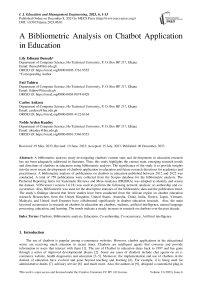A Bibliometric Analysis on Chatbot Application in Education
Автор: Lily Edinam Bensah, Fati Tahiru, Carlos Ankora, Noble Arden Kuadey
Журнал: International Journal of Education and Management Engineering @ijeme
Статья в выпуске: 6 vol.13, 2023 года.
Бесплатный доступ
A bibliometric analysis study investigating chatbots' current state and developments in education research has not been adequately addressed in literature. Thus, this study highlights the current state, emerging research trends and directions of chatbots in education using bibliometric analysis. The significance of the study is to provide insights into the most recent developments of chatbots application in education and future research directions for academics and practitioners. A bibliometric analysis of publications on chatbots in education published between 2012 and 2022 was conducted. A total of 759 publications were collected from the Scopus database for the bibliometric analysis. The Preferred Reporting Items for Systematic Reviews and Meta-Analyses (PRISMA) was adopted to identify and screen the dataset. VOSviewer (version 1.6.18) was used to perform the following network analysis: co-authorship and co-occurrence. Also, Bibliometrix was used for the descriptive statistics of the bibliometric data and the publication trend. The study’s findings showed that fewer studies have been conducted from the African region on chatbot education research. Researchers from the United Kingdom, United States, Australia, China, India, Greece, Japan, Vietnam, Malaysia, and United Arab Emirates have collaborated significantly in chatbot education research. Also, the main keyword occurrences in research on chatbots in education are chatbots, students, artificial intelligence, natural language processing, education, and learning. The trends indicate a steady increase in research on chatbots over the past decade.
Chatbots, Bibliometric analysis, Education, Co-authorship, Co-occurrence, Artificial intelligence
Короткий адрес: https://sciup.org/15018680
IDR: 15018680 | DOI: 10.5815/ijeme.2023.06.01
Текст научной статьи A Bibliometric Analysis on Chatbot Application in Education
The use of chatbots is popular among e-commerce websites. However, chatbot applications in the educational sector are receiving much attention in recent times. Chatbots are intelligent agents that converse and provide information to users that interact with them [1]. The use of Chatbot in education dates back to 1997 and has gone through a series of improved developmental phases [2]. Some use cases of chatbots include chat agents on an ecommerce website, health diagnostics and education [3–5]. Moreover, the implementation and use of chatbots in the domain of education have evolved and gone beyond teaching and learning [6]. For example, it is being used for administrative duties [7], advisory service [8] and much more. Also, the authors in [9], designed a customized plug-in chatbot for the Moodle learning environment using the Rasa Natural language processing framework to identify and address inadequacies and encourage students to engage in self-training to enhance their abilities. This resulted in a tool for teachers to assist and improve students (who were afraid of being judged by their colleagues) with problems in the course.
There are a number of reviews that have focused on specific aspects of research on chatbots in education. For instance, [6, 10] addressed the use of chatbots in education, focusing on the benefits and limitations of using a chatbot in education through a systematic review. The authors in [11] focused on the review of chatbot usage in education relating to the pedagogical concept. The authors in [12] study presented a systematic literature review by reporting on areas in education where chatbots have not been explored, while Caldarini et al., [13] presented a systematic review of the recent advances in terms of the use of Artificial Intelligence and Natural Language processing. Winkler and Soellner [14] equally conducted a systematic review based on a multi-perspective framework to show the potential of chatbots for increasing learning outcomes. Although prior reviews of the literature summarised similar works from a broad perspective or delved into specific areas of chatbots in education, there are limited studies that have addressed the current state of emerging research trends and directions of chatbots application in education.
The use of Chatbot in education has advanced, and researchers are interested in evaluating and monitoring its progress and usage in education [13, 14]. It is worth a while then for comprehensive review through the use of advanced scientific tools to evaluate and monitor the structure and the current trends and direction of published research in the discipline of Chatbot in education. Advanced scientific tools such as bibliometrics are increasingly used to sort data, including citations, author affiliations, keywords, themes discussed, and methods employed for published studies in different domains [15–18]. Bibliometric analysis is defined as “the statistical analysis of books, articles, or other publications to measure the output of individuals/research teams, institutions, and countries, to identify national and international networks, and to map the development of new multi-disciplinary fields of science and technology” [19]. Similarly, bibliometric analysis is considered a well-established method for reviewing published papers and identifying the current state of research in an area [20]. Text mining and citation analysis advancements have also enabled bibliometric analysis to deliver deeper and more extensive analyses than was previously possible [21]. As opposed to meta-analyses and systemic reviews, a bibliometric analysis can reveal better the links between existing publications [22].
Therefore, to address the limitations of prior studies, we use bibliometric analysis to investigate the current landscape of chatbot research in education and identify emerging trends. The research seeks to address the following research questions:
RQ1. What is the current state of chatbots in education research in terms of leading authors, significant publications and collaboration patterns?
RQ2. What are the main keyword occurrences in chatbots in education research?
RQ3. What are the trends and directions of research on chatbots in education?
The rest of the sections will be in the following order: section 1 presents an introduction to the study, section 2 discusses the literature relevant to the topic area, section 3 describes the methodology adopted for the study, section 4 presents the findings and discussions, and section 5 presents the limitations and conclusion of the study.
2. Literature Review
This section presents existing studies that are relevant to the current study of Artificial Intelligent (AI)-Chatbots in education.
-
2.1 Artificial Intelligence (AI) in education
-
2.2 Chatbots in education.
The application of AI technologies has impacted many sectors including the educational sector [23]. During the COVID-19 pandemic, the importance of AI and other educational technologies emerged to ensure the continuity of education and businesses. Although the application of AI in education has attracted much concern in the regions of ethical issues and data accountability, in almost all cases, the benefits outweigh the challenges. The transformational evidence in education is reflected in all areas of education, such as teaching, assessment, and administration [24]. For example, using chatbots in education has proven to improve teaching and learning [6]. The authors in [25–27] conducted a systematic literature review on the trends, benefits and challenges of using AI in education. Their results show the AI trends in education and the extent of benefits accrued in teaching and learning by the earlier implementors of AI technologies. Whereas the findings in [27] identified the current research dimension and focus on AI in education topics such as classification, matching, recommendation, and deep learning, that of [25, 26] posited that AI has already penetrated the education sector and aims to assist teachers but not replace them. The emergence of computers and the internet has “increased computing capabilities” and has therefore fostered the growth of AI applications in all areas of education.
On the other hand, the authors in [28] conducted an exploratory study to discover the opportunities and challenges of using AI in higher educational institutions in Romania and Serbia. The qualitative approach was adopted and multiple-answer questions were used to obtain data from participants’ perceptions to implement AI in education. The data was analysed using SmartPLS Software. The findings indicated that the use of AI in higher educational institutions (HEIs) is mostly impacted by the levels of skills in the application and the student's level of interest to use the technology. Similarly, the authors in [29] reviewed the current landscape of AI applications in HEIs and recommended future directions. Student learning experience, student support, and enrolment management were identified as key areas where AI technologies were successfully implemented, according to the findings of the study. The study of [30] emphasized the significance of AI implementation in education by highlighting nations that have given AI implementation in education a higher priority. The study utilized systems thinking and theory to analyze AI in education-related issues. The findings indicated that the need for AI training and the development of AI in education platforms is revealed by analyzing global AI education trends.
The use of artificial intelligence is revolutionizing the educational sector and has become a key strategy for enhancing national competitiveness and preserving national security. The authors in [30] reported on numerous nations that have pioneered the implementation of AI in education and others that have developed strategies to enhance its implementation and utilization. For example, in 2011, South Korea issued the "Implementation Plan of Promoting Intelligent Education Strategy" for the development of customized AI systems in education in 2015. In 2016, the "White House Office of Science and Technology Policy" of the United States of America announced, "Preparing for the Future of AI" and "National AI Research and Development Strategic Plan," which are geared toward the formulation of policy to address ethical issues in AI in education. To ensure compatibility between AI development and regulations, they are revising the existing regulatory framework and developing a more comprehensive implementation framework. Japan published the 'Human-Centered AI Social Principles' in 2018 to promote AI development in Japan, and Germany approved the 'AI Strategy Essentials' to promote rapid AI development in the same year. Since 2016, the Chinese have established plans for the informatization of education in order to develop strategies for the ongoing implementation of AI in education.
Chatbots are used in many sectors including education but its use as a pedagogical tool in education has seen an increase over the last few years due to the rapid development of AI [11, 26]. However, few studies suggest Chatbots are still at its infant stage of penetrating the educational sector [14, 33] and becoming AI teaching agents [13, 33]. The authors in [14] from the University of St. Gallen, Switzerland, did a state-of-the-art review of 1405 past researches in their attempt to unleash the potentials of Chatbots in education and their result revealed that the effectiveness of chatbots in education is intricate and dependent on various factors. In furtherance, the authors in [13] conducted content analysis of 316 articles on the recent advances on chatbots, where AI and natural language processing were used, and their results show that in spite of advancement in technology, AI Chatbots are still unable to simulate human speech which was attributed to dialogue modeling defect and “lack of learnt AI model for information retrieval Chatbots”. In [1], a model called Integ-Rela was proposed that could integrate multiple data retrieval from multiple domains. They developed a chatbot based on the proposed model using machine learning and natural language approach. The experimental results from the work of [1], indicated the practicality of the model as their chatbot acted as a tutor to help students locate the content of lessons, definitions, its practical applications and relevant research results.
There are many literatures on the use of Chatbots in education which have highlighted some challenges and benefits for teachers, students and administrators but the benefits far outweigh the challenges [2, 6, 10, 11, 34]. For example, Hamam [6] conducted a systematic literature review on the use of Chatbots in education with a focus on its benefits and limitations. The author’s findings highlighted the benefits of chatbots in education to include: improved teaching and learning, growing student’s engagement and personalized experience; and limitations to include technical, functional, privacy and security problems. The results of Hamam [6] are consistent with that of Chen et al., [34] in regards to students’ engagement when using Chatbots. Similarly, the authors in [35] conducted a systematic literature review to explore the potential of applying chatbot technology in educational settings. The author discovered that using chatbots in education offers many benefits, such as learners focusing more on their learning object when using voice Chatbots than navigating through various menus on a computer, Chatbots give a sense of satisfaction and encourage students to express themselves.
A number of earlier works have developed and evaluated the impact of chatbots in education and there has been some consistency in their findings [4, 9, 36, 37]. Python-Bot is a Chatbot that helps beginners to learn Python programming language. Its effectiveness was evaluated and results show a vast majority of students attesting that Python-Bot is user-friendly and enhances their Python programming skills by simplifying the programming logic [4]. MyAdvisor is a “chatbot-based academic advising system that helps students with prescriptive academic inquiries.” Evaluation of the system showed that students could get acquainted with the system quickly and found it helpful [8]. A similar Chatbot, University Academic Advisor Chatbot was designed to predict students’ academic performance so there can be early interventions for improvement. An empirical research was conducted to determine if the Chatbot has any significant impact in predicting students’ performance and the result was positive [37]. MentorChat is a conversational chatbot designed to support collaborative e-learning tasks in discussions. An experimental study which saw undergraduate students engaging in discussions online shows that the chatbot greatly improved individual and group learning outcomes [38]. In [39], the authors developed a conservational chatbot called Sara, the lecturer that can communicate with students in video-based settings through voice and text. An evaluation of the agent with 182 students indicated that Sara improved significantly learning outcomes in programming compared to more traditional conversational solutions.
There are a number of research on the implementation of chatbots in education, but none that address the current state, emerging trends and research directions. Therefore, this study seeks to conduct a bibliometric analysis of the current state, trends and directions of development in Chatbot in education.
3. Research Methodology 3.1 Method and Data Collection
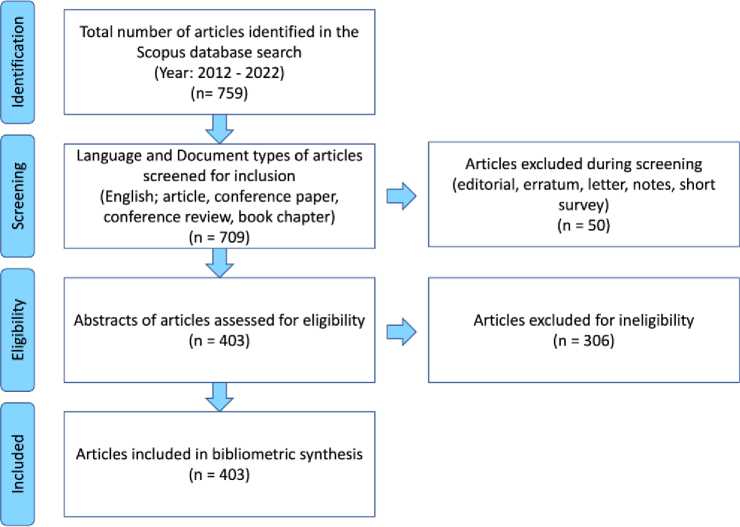
Fig. 1. Flow diagram for identification and screening of publication sources.
Table 1. Data source information
|
Data source |
Scopus |
|
Initial search query |
( TITLE-ABS-KEY ( chatbot* ) OR TITLE-ABS-KEY ( edubot* ) AND TITLE-ABS-KEY ( education* ) ) AND PUBYEAR > 2011 AND PUBYEAR < 2023 |
|
Search query (with exclusions) |
( TITLE-ABS-KEY ( chatbot* ) OR TITLE-ABS-KEY ( edubot* ) AND TITLE-ABS-KEY ( education* ) ) AND PUBYEAR > 2011 AND PUBYEAR < 2023 AND ( LIMIT-TO ( DOCTYPE , "cp" ) OR LIMIT-TO ( DOCTYPE , "ar" ) OR LIMIT-TO ( DOCTYPE , "cr" ) OR LIMIT-TO ( DOCTYPE , "ch" ) ) AND ( LIMIT-TO ( LANGUAGE , "English" ) ) |
|
Duration |
2012 – 2022 |
|
Retrieval date |
13th January 2023 |
3.2 Data Analysis
4. Results
4.1 Descriptive Statistics
The study conducted network analysis and descriptive analysis, respectively. VOSviewer (version 1.6.18), which is an application software for visualizing bibliometric networks [44] was used to perform the following network analysis: co-authorship (authors, organizations, country) and co-occurrence (All keywords). Also, bibliometrix, an R-tool for conducting research in bibliometrics [45] was used for the descriptive statistics of the bibliometric data and the publication trend.
Table 2. Descriptive analysis of bibliometric data
|
Articles |
403 |
|
Timespan |
2012-2022 |
|
Annual Percentage Growth Rate |
50.97% |
|
Average citations per article |
6.181 |
|
Authors |
1299 |
|
Author Appearances |
1505 |
|
Authors of single authored articles |
29 |
|
Authors of multi authored articles |
1270 |
|
Articles per Author |
0.31 |
|
Authors per Article Index |
3.22 |
|
Co-Authors per Articles Index |
3.73 |
Table 3. Descriptive analysis of Most Productive Authors
|
Authors |
Number of Articles |
Citations |
|
Lombardi M |
6 |
121 |
|
Chen Y |
6 |
20 |
|
Colace F |
5 |
112 |
|
Santaniello D |
5 |
76 |
|
Hobert S |
5 |
57 |
|
Gonda DE |
4 |
39 |
|
Konstantinidis ST |
4 |
16 |
|
Bamidis PD |
4 |
7 |
|
Ito T |
4 |
3 |
|
Miyazaki K |
4 |
3 |
Table 4. Top 10 Most Cited Publications
Table 5. Top 10 Most Productive Countries (based on corresponding author)
|
Country |
Number of Articles |
Frequency |
|
United Kingdom |
15 |
0.0872 |
|
China |
12 |
0.0698 |
|
Hong Kong |
11 |
0.0640 |
|
India |
10 |
0.0581 |
|
Spain |
10 |
0.0581 |
|
Korea |
8 |
0.0465 |
|
USA |
7 |
0.0407 |
|
Italy |
6 |
0.0349 |
|
Malaysia |
6 |
0.0349 |
|
Morocco |
6 |
0.0349 |
-
4.2 Network Analysis
-
4.2.1 Co-authorship: Authors, Organizations, Country
-
From Figure 2, there are 140 authors that are grouped into 49 clusters, with cluster 1 consisting of 10 authors, which is the highest number of authors in a particular cluster and with several clusters consisting of 1 author. Each author has a minimum of 2 research articles. We also found the top 10 collaborative authors based on the total link strength. The most collaborative authors are as follows: Konstantinidis ST (22); Bamidis PD (20); Karlgren K (20); Lombardi M (20); Pattichis CS (20); Stathakarou N (20); Henderson J (18); Pears M (18); Arndt T (17); Colace F (17).
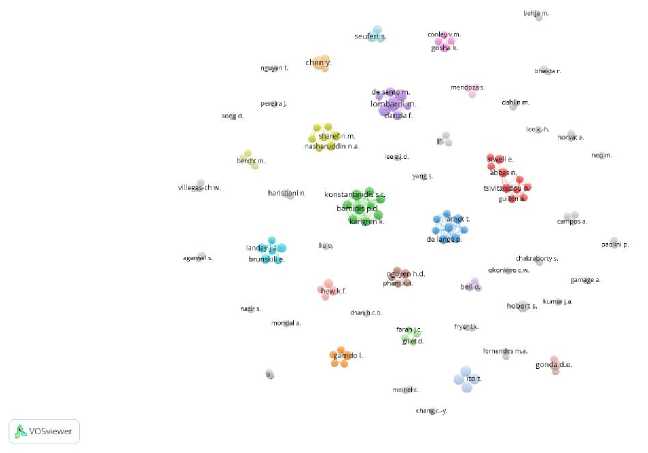
Fig. 2. Co-authorship by authors
As shown in Figure 3, there are 28 organisations that are grouped into 22 clusters, with each cluster consisting of either 2 or 1 organisation. Each organization has a minimum of 2 documents with Cyens Centre of Excellence, which is the biggest node in the network diagram, and has 5 research articles. Also, it was observed that the following organizations had a total link strength of 2: Universidad Internacional Del Ecuador; Universidad De Las Américas, Ecuador; Hanoi University of Industry, Hanoi, Vietnam; International College of Technology, Kanazawa, Japan; Kanazawa Institute Of Technology, Nonoichi, Japan; Kiet Group of Institutions, Delhi-Ncr; Stanford University, United States; Tsinghua University, China. On the other hand, the following oranisations had a total link strength of 1: University Of Hong Kong, Hong Kong; and Cyens Center of Excellence, Nicosia, Cyprus.
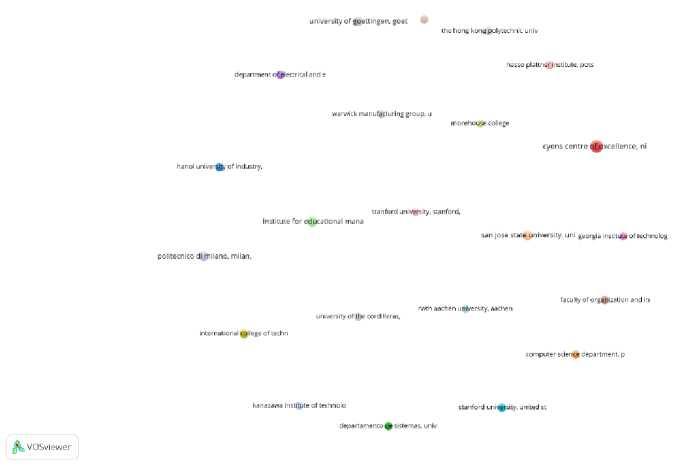
Fig. 3. Co-authorship by organizations
As shown in Figure 4, there are 53 countries that are grouped into 20 clusters, with cluster 1 consisting of 7 countries, which is the highest number of countries in a particular cluster and with several clusters consisting of 1 country. Each country has a minimum of 2 research articles, with India (40), United Kingdom (37), United States (35), Hong Kong (23) and Germany (22) having the highest number of research articles, respectively. In addition, it was observed that the following top 10 countries United Kingdom (24), Greece (14), Cyprus (13), United States (12), China (11), Australia (10), Sweden (9), Saudi Arabia (7), Hong Kong (6) and Spain (6) have the highest total link strengths.
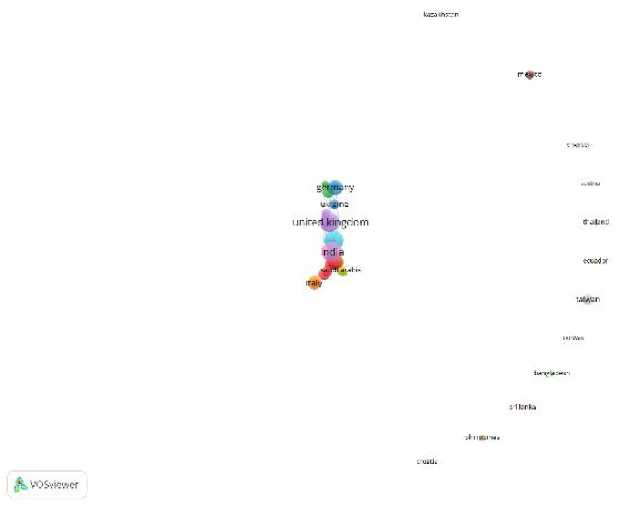
Fig. 4. Co-authorship by countries
-
4.2.2 Co-occurrence: All keywords
As shown in Figure 5, 117 keyword items were visualized using VOSviewer and these keywords were grouped into seven (7) clusters. Clusters 1 and 2 consist of 24 and 21 keyword items respectively. Both cluster 3 and 4 consist of 19 keyword items, while cluster 5, 6 and 7 consist of 17, 10, and 7 keyword items respectively. Cluster 1 consists of keyword items such as education, learning, educational technology and user interfaces, while cluster 2 consists of keyword items such as chatbots, natural language processing, machine learning and deep learning. On the other hand, cluster 3 consists of keyword items such as students, conversational agents, engineering education, and teaching, while cluster 4 consists of artificial intelligence, e-learning, virtual assistants and intelligent systems. Cluster 5 consists of keyword items such as chatbot, computer programming, higher education and information systems. Furthermore, it was observed that clusters 5, 2, 3 and 4 represent the bigger nodes, which are located at the central part of the network diagram. These bigger nodes represent keyword items that occurred most frequently. Specifically, it was observed from the co-occurrence analysis that the following keyword items are the ones that occurred most frequently: Chatbot/chatbots (375), students (154), artificial intelligence (115), natural language processing/ natural language processing systems/ natural languages (110), e-learning (107), conversational agents (70), learning systems/ learning management systems (69), education (47), engineering education (43), education computing (38), higher education (33), teaching/ learning/ teaching and learning (48).
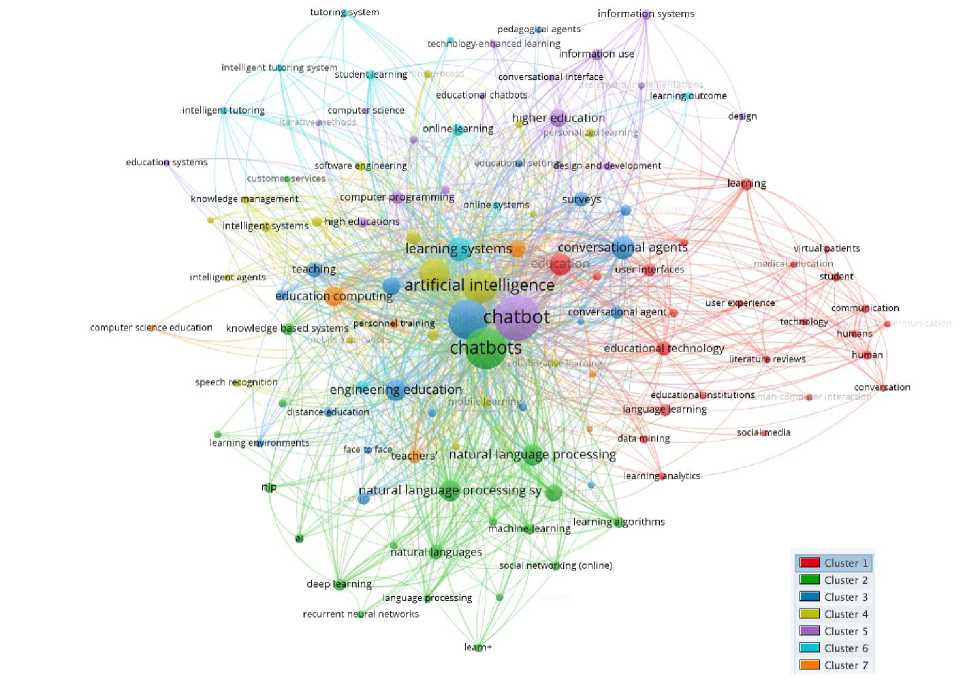
educational chatbots learningjcutcome design education#! settina^sjgn and development knowledge management high educations intelligent syster learning systems intelligent agents chatbot chatbots
:arnin!
learnin^analytics computar science
■l^ethods । .
Itural langu W processing sy л .
intelligent tutoring system, , , .
studentyearning
Face в ^=«tea^ers. natural langigge processing communication technology . . *
hunaans education^echnology literature reviews artificial intelligence education computing engineering education distance^ducation computer programming
’" online systems deep learning language processing recurrent neural networks higher education online learning personalized learning'
virtual ftitients iedk a I(id в cat ion student informatigp system;
pedagogies! agents techflblogy-enlianced learning in formal on use educationa^nstitutions languag§Jearning nversattonal agen^
*on user ii^rfaces tutori ngsystem intelligent tutoring speech recognition soda tenedia
□ Cluster 2
II ■ Cluster 3 11 И Cluster 4 lEZil Cluster 5
II 1 Cluster 6
II I Cluster 7
* . . , . learningOgorithms machin^earning natural languages social networking (online)
computer science education knowledge bjsed systems Personnel training
Fig. 5. Co-occurrence by all keywords
4.3 Publication Trends
From Figure 6 below, the years 2012 and 2013 saw a relatively low number of publications (2 and 3, respectively). 2014 did not have any publications relating to chatbots in education whereas 2015 witnessed a decline in publications, with just one publication. Starting from 2016, there was a consistent increase in the number of publications each year, demonstrating a sustained interest in the topic. The years 2018 and 2019 marked a notable increase in publications (22 and 51, respectively) compared to the preceding years. In recent years (2020, 2021, and 2022), there has been a significant increase in the number of publications - 73, 118 and 123, respectively. The data shows a clear upward trend in the number of publications in relation to chatbots in education.
5. Discussions and Implications
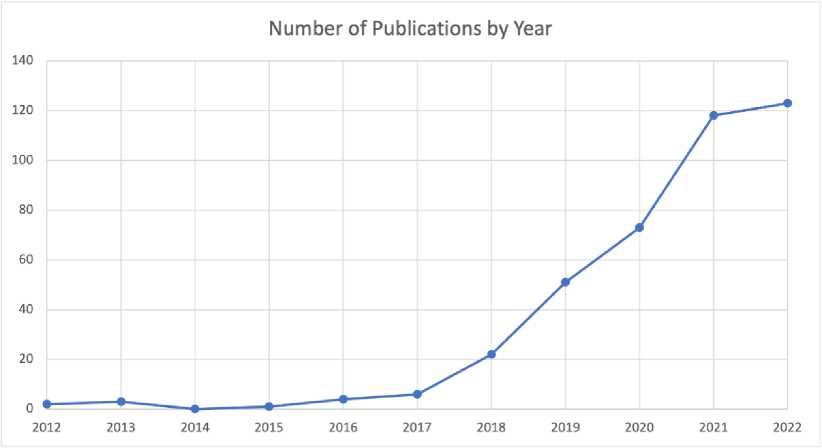
Fig. 6. Publication trends
The use of chatbots in education has evolved through various aspects of the educational sector, mainly academic and administrative. Thus, it is important to study the present state and trends of chatbots in education research. Consequently, this study sought to answer the three main research questions, which can provide future research direction for chatbots in education.
RQ1. What is the current state of chatbots in education research, in terms of leading authors, significant publications and collaboration patterns?
To address RQ1, the study conducted a network analysis on co-authorship. In terms of leading authors, the findings showed that the top 10 most productive authors with the highest number of publications are Lombardi M (6) with 121 citations, Chen Y. (6) with 20 citations, Colace F. (5) with 112 citations, Santaniello D (5) with 76 citations, Hobert S. (5) with 57 citations, Gonda D.E. (4) with 39 citations, Konstantinidis S.T. (4) with 16 citations, Bamidis P.D. (4) with 7 citations, Ito T. (4) with 3 citations and Miyazaki K. (4) with 3 citations. As a result of this study, Lombardi M. is the most influential author in chatbot education research. Concerning significant publications, it was observed that the most significant publications had citations between 62 and 149. Smutny and Schreiberova (2020) was the most cited with 149 citations. The second most cited Chen L. (2020) had 129 citations. Also, Fryer L.K (2017) had 119 citations, while Fryer L.K (2019) had 83 citations and Ruan S. (2019) had 62 citations respectively. Research works that receive more citations contribute significantly to chatbot education research., This suggests that the researchers are oriented toward research on chatbots in education and has led to the recent development of intelligent chatbots in education to augment teaching and learning [1]. The authors with the strongest total link strengths were considered for collaboration patterns. The most collaborative authors are as follows: Konstantinidis ST (22); Bamidis PD (20); Karlgren K (20); Lombardi M (20); Pattichis CS (20); Stathakarou N (20); Henderson J (18); Pears M (18); Arndt T (17); Colace F (17). In terms of collaboration patterns concerning organizations, total link strengths were considered. 10 organizations were identified as the most collaborative organizations. The following organizations: Universidad Internacional Del Ecuador; Universidad De Las Américas, Ecuador; Hanoi University of Industry, Hanoi, Vietnam; International College of Technology, Kanazawa, Japan; Kanazawa Institute Of Technology, Nonoichi, Japan; Kiet Group of Institutions, Delhi-Ncr; Stanford University, United States; Tsinghua University, China had a total link strength of 2. On the other hand, the following oranisations had a total link strength of 1: University of Hong Kong, Hong Kong; and Cyens Center of Excellence, Nicosia, Cyprus. Similarly, collaboration patterns were considered in relation to countries based on the total link strength. Researchers in the following top 10 countries, namely United Kingdom, Greece, Cyprus, United States, China, Australia, Sweden, Saudi Arabia, Hong Kong and Spain have played prominent roles in terms of collaboration. Researchers in the United Kingdom were the most collaborative with a total link strength of 24.
These findings suggest that researchers in the United Kingdom have been at the forefront of collaborative studies on the role of chatbots in education. Even though the findings also showed that it is only researchers from one African country that has been active in collaborative chatbot education research, there are no African organizations in the top 10 most collaborative organizations in chatbot smart education research. Since prior research has shown the potential benefits of chatbots in improving teaching and learning[6], there is a need for researchers from other African countries and organizations to consider collaborative chatbot education research.
RQ2. What are the main keyword occurrences in chatbots in education research?
To address this RQ2, the study conducted a network analysis on co-occurrence to identify the main keyword occurrences in chatbot educational research. The findings from the keywords from the co-occurrence analysis showed that the main keyword occurrences in chatbots educational research are: chatbot/chatbots, students, artificial intelligence, natural language processing/ natural language processing systems/ natural languages, e-learning, conversational agents, learning systems/ learning management systems, education, engineering education, education computing, higher education, teaching/ learning/ teaching and learning. The study’s findings on main keyword occurrences show the growing interest in chatbots in educational research, where these keywords feature predominantly in their study. Furthermore, the findings show that chatbots and students are the most prominent keywords, which implies that most research works in education focused on students who are part of the stakeholders in education. This is consistent with the findings of [2, 8, 46], which suggest that students are beneficiaries of chatbots in education [25, 26]. Also, keywords such as education computing and engineering education featured prominently among the top 10 keywords, which implies that chatbot research has been conducted more in the disciplines of computing and engineering than other disciplines in the education field.
RQ3. What are the trends and directions of research on chatbots in education?
To address this RQ3, the study conducted publication trends of research works conducted on chatbots in education research from 2012 to 2022. The introduction of chatbots in education, which has steadily increased over the past decade, as shown in Figure 6, has been an emerging research. In 2018, it was observed that there was a significant increase in the number of publications, with a total number of 22 publications in 2018 as compared to 6 publications in 2017. Subsequently, the number of publications increased from 22 to 51 in 2019, 51 to 73 in 2020 and 73 to 118 in 2021, and by the end of 2022, there were 123 publications. These findings show a steady increase in publications on chatbots in education, which implies that the role of chatbots in education is gaining attention from the research community. In particular, the emergence of COVID-19 in 2019, necessitated institutions to adopt e-learning environments to facilitate teaching and learning online. The adoption of these e-learning environments that had artificial intelligent chatbots incorporated served as new teacher assistants in assisting students in their learning processes [6]. Thus, the significant increase in research on chatbots between 2019 and 2022 can be attributed to the COVID-19 pandemic. Similarly, the high occurrences of keyword items such as chatbot, students, e-learning, and higher education that are in clusters 2,3, 4 and 5, respectively, in Figure 5 suggest the emerging trends of chatbot education research. Furthermore, the high frequency of keywords such as chatbots that were observed in clusters 2 and 5 corroborates the findings of [6] that suggest the role of chatbots in improving teaching and learning. Similarly, the high occurrence of artificial intelligence that is in cluster 4 corroborates the findings of [25, 26] that suggest the penetration of AI in education. In addition, technologies such as artificial intelligence provide the opportunity for developing intelligent chatbot systems such as AI-teaching agents for education. Thus, future research should consider the interoperability of chatbots, artificial intelligence, and e-learning systems in developing learning and teaching agents in educational sector. Also, it was observed from the network keyword co-occurrences that teachers or instructors facilitating teaching and learning did not feature prominently among the keywords. This may be due to the self-learning nature of chatbots which does not require facilitation. It equally implies that there is limited literature that focuses on teachers or instructors even though prior studies [25, 26] posit the benefits teachers can derive from the chatbot. Thus, future research must also focus on how teachers or instructors and administrators can leverage chatbot systems in the education sector. Similarly, the study’s findings on network keyword co-occurrences showed that there is limited occurrence of humanities, arts and business keywords. This implies that not much study has been conducted on the role of chatbots in supporting teaching and learning in disciplines such as humanities, arts and business. Therefore, future research must also focus on how chatbots can support teaching and learning in disciplines such as humanities, arts and business. The findings also showed that the United Kingdom was the most productive country based on the corresponding author. The Asian region had the most countries in the top ten most productive countries, while Morocco was the only African country in the top-ten list. This suggests that not much study has been conducted on implementing chatbots in education in the African region. Thus, researchers from the African continent should leverage on the benefits of chatbots in education as posited by [25, 26] and consider conducting research on chatbots in education.
6. Conclusion
While there have been previous literature reviews that discussed chatbots in education from a general or specific perspective, few studies have focused on the current state of emerging research trends and directions for chatbot applications in education. Thus, to address the limitations of previous studies, this study investigated the current state of chatbot research in education, development directions, and its evolving trends in education using bibliometric analysis.
The findings showed that in recent times researchers are oriented toward research on chatbots in education and Lombardi M. is the most influential researcher. Currently, the results showed that little research has been conducted from the African region on chatbot education research. Similarly, the results from the keyword occurrences showed that topics in chatbot education research had been largely intertwined with keywords such as chatbots, students, artificial intelligence, natural language processing, e-learning and education. The study’s findings also indicated that chatbot research has been conducted in disciplines such as computing and engineering more than other disciplines in the education field. Equally, the results show that since 2018, there had been a significant increase in research publications on chatbot education and the United Kingdom has been the most productive country based on the corresponding author. However, the findings showed that Morocco was the only African country in the top-ten most productive countries. These findings from the study imply that there should be more collaborations between researchers, especially from the African region with diverse expertise, on developing intelligent chatbot systems for educational purposes. , Future research may investigate how chatbots can support teaching and learning in diverse disciplines such as humanities, arts and businesses. In addition, the study can be useful to researchers who may want to extend the application of chatbots to different educational contexts, such as teachers and administrators. In conclusion, this study seeks to provide insights into the most recent developments of chatbots in education and future research directions for academics and practitioners.
Conflicts of Interest
The authors have no conflicts of interest to declare that are relevant to the content of this article.
Список литературы A Bibliometric Analysis on Chatbot Application in Education
- H. D. Nguyen, T. V. Tran, X. T. Pham, A. T. Huynh, V. T. Pham, and D. Nguyen, “Design Intelligent Educational Chatbot for Information Retrieval based on Integrated Knowledge Bases,” IAENG Int J Comput Sci, vol. 49, no. 2, 2022.
- G. Molnar and Z. Szuts, “The Role of Chatbots in Formal Education,” SISY 2018 - IEEE 16th International Symposium on Intelligent Systems and Informatics, Proceedings, pp. 197–201, 2018, doi: 10.1109/SISY.2018.8524609.
- I. C. Hsu and J. De Yu, “A medical Chatbot using machine learning and natural language understanding,” Multimed Tools Appl, pp. 23777–23799, 2022, doi: 10.1007/s11042-022-12820-4.
- C. W. Okonkwo and A. Ade-Ibijola, “Python-bot: A chatbot for teaching python programming,” Engineering Letters, vol. 29, no. 1, pp. 25–34, 2021.
- S. Pede and M. L. Saini, “A Brief Bibliometric Analysis and Visualization of Scopus and WoS databases on Blockchain Technology in Healthcare Domain,” Library Philosophy and Practice, vol. 2021, pp. 1–27, 2021.
- D. Hamam, The New Teacher Assistant: A Review of Chatbots’ Use in Higher Education, vol. 1421. Springer International Publishing, 2021. doi: 10.1007/978-3-030-78645-8_8.
- S. Yang and C. Evans, “Opportunities and challenges in using AI chatbots in higher education,” ACM International Conference Proceeding Series, pp. 79–83, 2019, doi: 10.1145/3371647.3371659.
- M. A. Kuhail, H. Al Katheeri, J. Negreiros, A. Seffah, and O. Alfandi, “Engaging Students With a Chatbot-Based Academic Advising System,” Int J Hum Comput Interact, vol. 0, no. 0, pp. 1–27, 2022, doi: 10.1080/10447318.2022.2074645.
- K. Gaglo, B. M. Degboe, G. M. Kossingou, and S. Ouya, “Proposal of conversational chatbots for educational remediation in the context of covid-19,” International Conference on Advanced Communication Technology, ICACT, vol. 2022-Febru, pp. 354–358, 2022, doi: 10.23919/ICACT53585.2022.9728860.
- C. W. Okonkwo and A. Ade-Ibijola, “Chatbots applications in education: A systematic review,” Computers and Education: Artificial Intelligence, vol. 2, p. 100033, 2021, doi: 10.1016/j.caeai.2021.100033.
- M. Ashok, K. Ramasamy, G. Snehitha, and S. R. Keerthi, “A Systematic Survey of Cognitive Chatbots in Personalized Learning Framework,” 2021 International Conference on Wireless Communications, Signal Processing and Networking, WiSPNET 2021, pp. 241–245, 2021, doi: 10.1109/WiSPNET51692.2021.9419403.
- S. Wollny, J. Schneider, D. Di Mitri, J. Weidlich, M. Rittberger, and H. Drachsler, “Are We There Yet? - A Systematic Literature Review on Chatbots in Education,” Front Artif Intell, vol. 4, no. July, pp. 1–18, 2021, doi: 10.3389/frai.2021.654924.
- G. Caldarini, S. Jaf, and K. McGarry, “A Literature Survey of Recent Advances in Chatbots,” Information (Switzerland), vol. 13, no. 1, pp. 0–22, 2022, doi: 10.3390/info13010041.
- R. Winkler and M. Soellner, “Unleashing the Potential of Chatbots in Education: A State-Of-The-Art Analysis,” Academy of Management Proceedings, vol. 2018, no. 1, p. 15903, 2018, doi: 10.5465/ambpp.2018.15903abstract.
- M. Ali, R. Rahimi, F. Okumus, and J. Liu, “Annals of Tourism Research Bibliometric studies in tourism,” vol. 61, pp. 180–198, 2016.
- D. Kalibatiene and J. Miliauskaitė, “A systematic mapping with bibliometric analysis on information systems using ontology and fuzzy logic,” Applied Sciences (Switzerland), vol. 11, no. 7, 2021, doi: 10.3390/app11073003.
- K. C. Li and B. T. M. Wong, “Research landscape of smart education: a bibliometric analysis,” Interactive Technology and Smart Education, vol. 19, no. 1, pp. 3–19, 2022, doi: 10.1108/ITSE-05-2021-0083.
- M. Pears and S. Konstantinidis, “Bibliometric Analysis of Chatbots in Health-Trend Shifts and Advancements in Artificial Intelligence for Personalized Conversational Agents,” vol. 2020, pp. 494–498, 2022, doi: 10.3233/shti220125.
- M. Kamran, H. Ullah, W. Nisar, M. Farooq, and S. Rehman, “Blockchain and Internet of Things : A bibliometric study ✩,” vol. 81, 2020.
- X. Ding and Z. Yang, “Knowledge mapping of platform research: a visual analysis using VOSviewer and CiteSpace,” Electronic Commerce Research, no. 0123456789, 2020, doi: 10.1007/s10660-020-09410-7.
- N. J. van Eck and L. Waltman, “Citation-based clustering of publications using CitNetExplorer and VOSviewer,” Scientometrics, vol. 111, no. 2, pp. 1053–1070, 2017, doi: 10.1007/s11192-017-2300-7.
- Y. Lin and Z. Yu, “A bibliometric analysis of artificial intelligence chatbots in educational contexts,” Interactive Technology and Smart Education, 2023, doi: 10.1108/ITSE-12-2022-0165.
- F. Tahiru and S. Agbesi, “The Future of Artificial Intelligence in Education,” in Digital Technology Advancements in Knowledge Management , 2021, pp. 187–194. doi: 10.4018/978-1-7998-6792-0.ch010.
- S. F. Ahmad, M. M. Alam, M. K. Rahmat, M. S. Mubarik, and S. I. Hyder, “Academic and Administrative Role of Artificial Intelligence in Education,” Sustainability (Switzerland), vol. 14, no. 3, pp. 1–11, 2022, doi: 10.3390/su14031101.
- L. Chen, P. Chen, and Z. Lin, “Artificial Intelligence in Education: A Review,” IEEE Access, vol. 8, pp. 75264–75278, 2020, doi: 10.1109/ACCESS.2020.2988510.
- F. Tahiru, “AI in education: A systematic literature review,” Journal of Cases on Information Technology (JCIT), vol. 23, no. 1. pp. 1–20, 2021. doi: 10.4018/JCIT.2021010101.
- X. Zhai et al., “A Review of Artificial Intelligence (AI) in Education from 2010 to 2020,” Complexity, vol. 2021, 2021, doi: 10.1155/2021/8812542.
- R. Bucea-Manea-țoniş et al., “Artificial Intelligence Potential in Higher Education Institutions Enhanced Learning Environment in Romania and Serbia,” Sustainability (Switzerland), vol. 14, no. 10, pp. 1–18, 2022, doi: 10.3390/su14105842.
- E. Hannan and S. Liu, “AI: new source of competitiveness in higher education,” Competitiveness Review, 2021, doi: 10.1108/CR-03-2021-0045.
- J. Qu, Y. Zhao, and Y. Xie, “Artificial intelligence leads the reform of education models,” Syst Res Behav Sci, no. April, pp. 581–588, 2022, doi: 10.1002/sres.2864.
- M. L. Owoc, A. Sawicka, and P. Weichbroth, “Artificial Intelligence Technologies in Education: Benefits, Challenges and Strategies of Implementation,” IFIP Adv Inf Commun Technol, vol. 599, no. August, pp. 37–58, 2021, doi: 10.1007/978-3-030-85001-2_4.
- A. McFarland, “10 Best AI Tools for Education,” https://www.unite.ai/10-best-ai-tools-for-education/, 2022, Accessed: Aug. 04, 2022. [Online]. Available: https://www.unite.ai/10-best-ai-tools-for-education/
- P. Smutny and P. Schreiberova, “Chatbots for learning: A review of educational chatbots for the Facebook Messenger,” Comput Educ, vol. 151, no. June 2019, p. 103862, 2020, doi: 10.1016/j.compedu.2020.103862.
- Y. Chen, S. Jensen, L. J. Albert, S. Gupta, T. Lee, and L. J. Albert, “Artificial Intelligence ( AI ) Student Assistants in the Classroom : Designing Chatbots to Support Student Success,” Information Systems Frontiers, no. 0123456789, 2022, doi: 10.1007/s10796-022-10291-4.
- G. Dimitriadis, “Evolution in Education: Chatbots,” Homo Virtualis, vol. 3, no. 1, p. 47, 2020, doi: 10.12681/homvir.23456.
- S. Hobert, Individualized Learning Patterns Require Individualized Conversations – Data-Driven Insights from the Field on How Chatbots Instruct Students in Solving Exercises, vol. 13171 LNCS. Springer International Publishing, 2022. doi: 10.1007/978-3-030-94890-0_4.
- M. S. Lim, S. B. Ho, and I. Chai, Design and Functionality of a University Academic Advisor Chatbot as an Early Intervention to Improve Students’ Academic Performance, vol. 724. Springer Singapore, 2021. doi: 10.1007/978-981-33-4069-5_15.
- S. Tegos and S. Demetriadis, “International Forum of Educational Technology & Society Conversational Agents Improve Peer Learning through Building on Prior Knowledge,” Source: Journal of Educational Technology & Society, vol. 20, no. 1, pp. 99–111, 2017.
- R. Winkler, S. Hobert, A. Salovaara, M. Söllner, and J. M. Leimeister, “Sara, the Lecturer: Improving Learning in Online Education with a Scaffolding-Based Conversational Agent,” Conference on Human Factors in Computing Systems - Proceedings, pp. 1–14, 2020, doi: 10.1145/3313831.3376781.
- J. Baas, M. Schotten, A. Plume, G. Côté, and R. Karimi, “Scopus as a curated, high-quality bibliometric data source for academic research in quantitative science studies,” Quantitative Science Studies, vol. 1, no. 1, pp. 377–386, 2020, doi: 10.1162/qss_a_00019.
- S. Neelam and S. K. Sood, “A Scientometric Review of Global Research on Smart Disaster Management,” IEEE Trans Eng Manag, vol. 68, no. 1, pp. 317–329, 2021, doi: 10.1109/TEM.2020.2972288.
- M. J. Page et al., “The PRISMA 2020 statement: An updated guideline for reporting systematic reviews,” The BMJ, vol. 372, 2021, doi: 10.1136/bmj.n71.
- P. Song and X. Wang, “A bibliometric analysis of worldwide educational artificial intelligence research development in recent twenty years,” Asia Pacific Education Review, vol. 21, no. 3, pp. 473–486, 2020, doi: 10.1007/s12564-020-09640-2.
- V. N. J. Eck and L. Waltman, “Visualizing Bibliometric Networks,” in Measuring Scholarly Impact, Y. Ding, R. Rousseau, and D. Wolfram, Eds., Springer, 2014, pp. 285–320. doi: https://doi.org/10.1007/978-3-319-10377-8_13.
- M. Aria and C. Cuccurullo, “bibliometrix: An R-tool for comprehensive science mapping analysis,” J Informetr, vol. 11, no. 4, pp. 959–975, 2017, doi: 10.1016/j.joi.2017.08.007.
- F. Clarizia, F. Colace, M. Lombardi, F. Pascale, and D. Santaniello, Chatbot: An education support system for student, vol. 11161 LNCS. Springer International Publishing, 2018. doi: 10.1007/978-3-030-01689-0_23.

